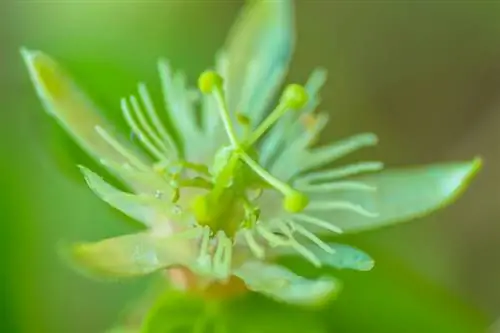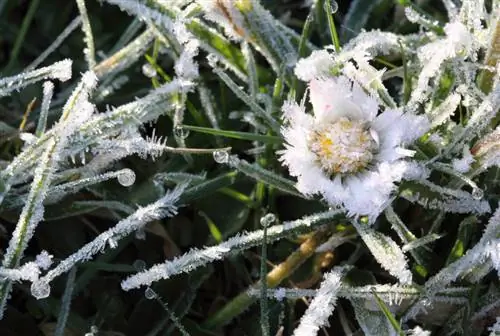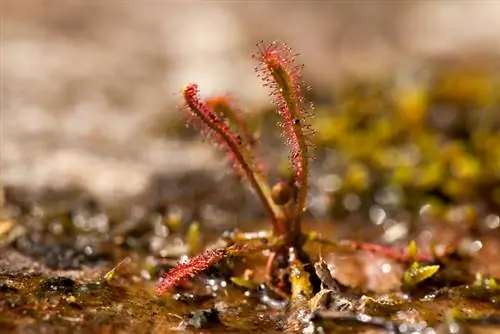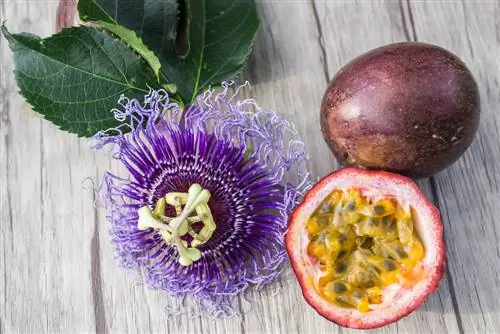- Author admin [email protected].
- Public 2023-12-16 16:46.
- Last modified 2025-06-01 06:02.
Passionflower is by no means the same as passionflower. There are over 500 different species, which are also at home in different climate zones. Although most passiflora come from subtropical and tropical regions of South America and are therefore not hardy, others also know the cold from their homeland.

Which passion flowers are hardy?
Some hardy passion flower species are Passiflora violacea (up to -10°C), P. tucumanensis (up to -15°C), P. incarnata (up to -15°C), P.lutea (up to -15°C) and P. caerulea (up to -15°C). For optimal overwintering, roots should be protected and in very cold regions the plants should be kept in a cold house.
Most passiflora are not hardy
With a few exceptions (see table below), passion flowers are not hardy - and even for the exceptions mentioned, the stated winter hardiness does not apply absolutely. Experienced gardeners recommend planting hardy passion flowers only in regions with mild winters; otherwise, all passiflora should overwinter in the house or greenhouse under cold house conditions if possible. Specifically this means:
- Cut down passionflower in autumn
- and bring it into the house as soon as the temperatures permanently fall below 10 "C.
- Wintering in a frost-free,
- but cool (max. 10 to 12 °C)
- and bright room.
- The more autumnal pruning, the darker the room can be.
- Do not fertilize.
- Fertilize little, but regularly.
If the hardy passionflower is to overwinter outside, the roots in particular should be protected with a thick layer of bark mulch and brushwood, and if necessary also with a cold protection fleece. Passionflowers grown as houseplants, on the other hand, remain where they are and may simply be cut back. But fertilization and watering should also be reduced for these specimens.
Hardy Passifora species
You will certainly find the hardy passionflower you are looking for in the table below. The species listed originally come from climate zones in which temperatures can easily drop below zero. Their frost hardiness is usually given as down to -15 °C, although this is only a rough estimate. If provided with appropriate winter protection, these passiflora can certainly overwinter outside in regions with mild winters. However, where experience shows that it gets very cold and snow is expected, this form of wintering is not advisable. The upper shoots can be radically cut down to around 15 to 20 centimeters in autumn; the plant will sprout again in spring from the rhizomes or root system.
| Passionflower - Type | Flower color | flower size | Frosthardiness | Special features |
|---|---|---|---|---|
| Passiflora violacea | violet | about 12 centimeters | up to approx. - 10 °C | very suitable for keeping in containers |
| P. tucumanensis | blue-white or purple-white banded | about 7 centimeters | up to approx. -15 °C | very distinctive flowers |
| P. incarnata (flesh-colored passionflower) | pink, red-violet or white | about 8 centimeters, with fringe-like, wavy extensions | up to approx. - 15 °C | Medicinal plant, considered the most frost-hardy passionflower |
| P. lutea | light green to white | about 2.5 centimeters | up to approx. - 15 °C | profusely blooming |
| P. caerulea (Blue Passionflower) | blue-white | about 10 centimeters | up to approx. - 15 °C | one of the most popular Passiflora species |
Tips & Tricks
Wake your passionflower slowly out of hibernation around March. But be careful with the sun: Do not place the plant directly in the midday sun, but rather slowly get used to it again.






